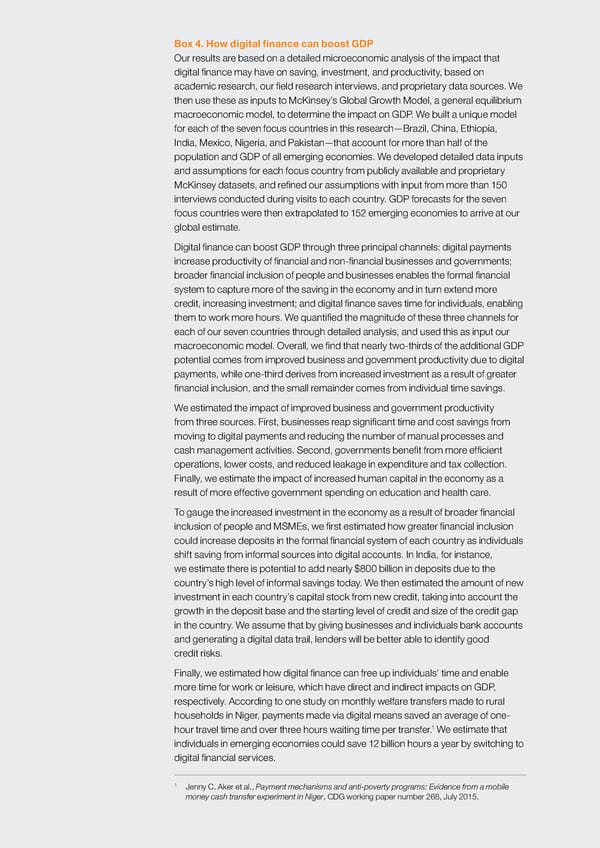Box 4. How digital finance can boost GDP Our results are based on a detailed microeconomic analysis of the impact that digital finance may have on saving, investment, and productivity, based on academic research, our field research interviews, and proprietary data sources. We then use these as inputs to McKinsey’s Global Growth Model, a general equilibrium macroeconomic model, to determine the impact on GDP. We built a unique model for each of the seven focus countries in this research—Brazil, China, Ethiopia, India, Mexico, Nigeria, and Pakistan—that account for more than half of the population and GDP of all emerging economies. We developed detailed data inputs and assumptions for each focus country from publicly available and proprietary McKinsey datasets, and refined our assumptions with input from more than 150 interviews conducted during visits to each country. GDP forecasts for the seven focus countries were then extrapolated to 152 emerging economies to arrive at our global estimate. Digital finance can boost GDP through three principal channels: digital payments increase productivity of financial and non-financial businesses and governments; broader financial inclusion of people and businesses enables the formal financial system to capture more of the saving in the economy and in turn extend more credit, increasing investment; and digital finance saves time for individuals, enabling them to work more hours. We quantified the magnitude of these three channels for each of our seven countries through detailed analysis, and used this as input our macroeconomic model. Overall, we find that nearly two-thirds of the additional GDP potential comes from improved business and government productivity due to digital payments, while one-third derives from increased investment as a result of greater financial inclusion, and the small remainder comes from individual time savings. We estimated the impact of improved business and government productivity from three sources. First, businesses reap significant time and cost savings from moving to digital payments and reducing the number of manual processes and cash management activities. Second, governments benefit from more efficient operations, lower costs, and reduced leakage in expenditure and tax collection. Finally, we estimate the impact of increased human capital in the economy as a result of more effective government spending on education and health care. To gauge the increased investment in the economy as a result of broader financial inclusion of people and MSMEs, we first estimated how greater financial inclusion could increase deposits in the formal financial system of each country as individuals shift saving from informal sources into digital accounts. In India, for instance, we estimate there is potential to add nearly $800 billion in deposits due to the country’s high level of informal savings today. We then estimated the amount of new investment in each country’s capital stock from new credit, taking into account the growth in the deposit base and the starting level of credit and size of the credit gap in the country. We assume that by giving businesses and individuals bank accounts and generating a digital data trail, lenders will be better able to identify good credit risks. Finally, we estimated how digital finance can free up individuals’ time and enable more time for work or leisure, which have direct and indirect impacts on GDP, respectively. According to one study on monthly welfare transfers made to rural households in Niger, payments made via digital means saved an average of one- 1 hour travel time and over three hours waiting time per transfer. We estimate that individuals in emerging economies could save 12 billion hours a year by switching to digital financial services. 1 Jenny C. Aker et al., Payment mechanisms and anti-poverty programs: Evidence from a mobile money cash transfer experiment in Niger, CDG working paper number 268, July 2015. McKinsey Global Institute Digital finance for all: Powering inclusive growth in emerging economies 51
 DIGITAL FINANCE FOR ALL Page 64 Page 66
DIGITAL FINANCE FOR ALL Page 64 Page 66